Deadshirt Is Reading… is a weekly feature in which Deadshirt’s staff, contributing writers, and friends-of-the-site offer their thoughts on Big Two cape titles, creator-owned books, webcomics and more. For more of our thoughts on this week’s new comics, take a look at Wednesday’s Deadshirt Comics Shopping List.
David Uzumeri is reading…
Written by Tom King
Art by Toby Cypress
Colored by Romulo Fajardo Jr.
Lettered by Pat Brosseau
DC Comics
“My father makes me kill people. Every morning, as the sun comes.”
Omega Men launched with an eight-page preview short where the relatively obscure group of DC characters murdered beloved Green Lantern Kyle Rayner live on space air in a mock ISIS beheading video. It hasn’t exactly gotten all that much less crazy or ballsy since.
I’ve been a fan of writer Tom King’s stuff since his Futures End issue of the Grayson ongoing; I recognize a co-plotting credit belongs to Tim Seeley on that, and artist Stephen Mooney is no slouch either, but King’s weird backwards narrative—beginning with Grayson and Helena Bertinelli’s near-death via deathtrap and ending with young Robin helping Batman crack a code—was not only a really clever narrative device, but also went a long way towards selling their concept of Dick Grayson as a living history of the DC Universe, where you can practically measure its maturity by his own life stages and reboots.
As a result, I had high hopes for Omega Men when King was announced as the writer, and the resulting work hasn’t disappointed at all. It’s a gritty, realistic series in the way that sentence used to mean, back in the days of the nine-panel grid regular artist Barnaby Bagenda and colorist Romulo Fajardo Jr. have been working in: violent without being gratuitous; pragmatic without being cynical; clever without being smug. King’s CIA background hugely informs his work on Omega Men; on one hand, he’s stated that he’s careful not to take sides and make this into an overtly real-world political comic. Then he introduces a revolutionary princess of a migrant population with a unique (in the Vega Sector) religious outlook who’s ordered by her ancestors to brutally murder the native population to ensure supremacy. It’s difficult to come away from this issue and think he might be a fan of Israel’s foreign policy. (Or, for that matter, of the Indian caste system, considering these people are named the “Brahmins.”)
This is a long and rambling way of saying that this issue, like the previous three, has really impressed the hell out of me. Previous issues have presented a fairly strict nine-panel grid view of the Omega Men’s freedom fighting and/or terrorist (depending on your point of view) actions to try to free the Vega System of its colonialist inhabitants; this issue, Toby Cypress takes a step back from that storytelling mechanism and gives us a reminder of why one of my favorite characters in superhero comics—‘90s Green Lantern Kyle Rayner—is so interesting. While the initial promotion for the book suggested this fan-favorite character got murdered before the #1 issue even started, this is far from the case; in fact, his faked death and current state are a central portion of the Omega Men’s plan, while he gets sort-of honeypotted by the Omega Men’s leader, the aforementioned princess of Murder Planet who feels really shitty about being ordered to murder a bunch of indigenous folks every morning.
It’s a weird, gutsy, ambitious comic, twisting the entire DC Universe into a morally grey realpolitik ideological jungle. I’m not quite sure how it got greenlit, but I’m glad it did. It’s only four issues in, and I could definitely end up getting disappointed—both narratively and ideologically—by the way it continues, but these first four issues have been a deft, mature examination of incredibly difficult issues, with the benefit of obfuscation a fictional space alien universe provides. It’s the kind of Green Lantern book I always wanted to read, honestly. It just stars the Omega Men.
Max Robinson is reading…
Written by Jason Aaron
Art by Chris Sprouse and Goran Sudzuka
Inked by Karl Story & Dexter Vines
Colored by Marte Garcia with Israel Silva
Lettered by VC’s Joe Sabino
Marvel
“Good luck with your Allthing ‘Ultimate’ Thor.”
Thors is the most batshit tie-in to a Marvel event that’s made up of insane, swing-for-the-fences concepts. There’s some serious commitment to the bit here: if alternate universe versions of Thor are the police of God Doom’s dystopic Battleworld, it stands to reason that their tie-in book is a full blown cop drama. The mini-series lays on the Law & Thorder paint pretty heavy, but Aaron plays up the silliness of the conceit (a Simonson-style frog Thor is a forensics cop) alongside a strong central conflict (Who is killing all the Jane Fosters and Donald Blakes across Battleworld?), and it all somehow works.
Thors #3, in keeping with the spirit established so far, is mostly a locked room interrogation scene in the grand tradition of Homicide: Life on the Street and The Dark Knight. Only this time it’s super-cop “Ultimate Thor” facing a ticking clock with a derelict Loki in the hot seat. This sequence was immensely satisfying, and Aaron really demonstrates a solid grip on the core of who Thor and Loki are as characters. Thor’s varying attempts to reason with or outwit Loki are fruitless, and you can feel the tension between the longtime brothers/foes emanate off the page. There’s enough pathos and clever dialogue in their back and forth that it doesn’t feel like the book is spinning wheels either, which is a plus. My only real gripe is the fill-in pages from Goran Sudzuka in several spots during this sequence, that were somewhat distracting and not up to the level of quality Sprouse has brought art-wise. (It’s especially jarring to see Sprouse’s fairly naturalistic Thor sprout wide-eyed manga eyes).
The other major thing that happens in this issue, that I won’t spoil but is such a classic cop show beat that we all should’ve seen it coming, kicks the series into the next gear in a cool way. I really dig how many of the Secret Wars tie-ins take full advantage of the fact that there’s, say, a walled off section of the planet filled with superpowered zombies or all-Hulks. The end of this month’s Thors capitalizes on having that around nicely and suggests we’re about to see Some Shit Go Down.
Kayleigh Hearn is reading…
 Miracleman by Gaiman & Buckingham #1
Miracleman by Gaiman & Buckingham #1
Written by Neil Gaiman
Art by Mark Buckingham
Colored by D’Israeli
Lettered by Todd Klein
Marvel
“After three hours of climbing, we lost him for good.”
“I feel a little stage fright,” wrote Neil Gaiman in the original script for Miracleman #17, over twenty-five years ago, as he was about to take over the title from Alan Moore. It doesn’t sound like false modesty. Though he’d already begun writing Sandman, the young Mr. Gaiman of course had no way of knowing his work would become one of the most critically acclaimed comic series of all time. He goes on to say that he knows with dread certainty that whatever he writes will be compared to Alan Moore, but he didn’t have to worry. Decades later, I’m reading Miracleman #17 reprinted with Neil Gaiman and artist Mark Buckingham’s names included in the title—and Alan Moore’s name can’t even be printed.
Miracleman by Gaiman and Buckingham #1 consists of three pieces, including a prologue and a short story, “Retrieval,” which was serialized over several issues. Most of the issue is dedicated to the story “A Prayer and Hope,” in which four pilgrims ascend Olympus in order to speak to the godlike Miracleman. Read today, the story is a fascinating glimpse of a writer developing his voice. Gaiman wisely didn’t try to imitate Moore—this definitely feels like a Gaiman comic, but so much so that it doesn’t feel like Miracleman. At least, not yet. The comic feels like an early issue of Sandman dressed up in blue and red tights. The surreal, endless, nightmarish staircase in Olympus could be The Dreaming, and Miracleman’s cold, inscrutable, inhuman nature (especially when he seemingly favors a woman’s artistic ambitions over a man’s plea for his daughter’s life) makes him sound like Morpheus with a rosier complexion. The beginning of Gaiman’s run shows a literary writer just discovering how smart he can be, even if the results are a little too cute. (Dear reader, which David Bowie song do you think will be quoted in an arc called “The Golden Age?” You only get one guess.)
It’s interesting to watch the development of Mark Buckingham’s art as well, and thankfully Marvel’s reprinting of the issue includes a welcome sampling of his original art. His artwork here is appropriately surreal, verging on cosmic horror—like the unlucky travelers in Lovecraft’s fiction, the pilgrims here brush against something vast and unknowable, though instead of Cthulhu it’s the golden god Miracleman. I’m thoroughly excited to follow the development of his art as the Miracleman story reaches its long-awaited ending—his brand new cover for the issue is gorgeous.
One last thing I noticed: Neil Gaiman’s newest comic work, The Sandman: Overture, features an ill-fated little girl named Hope. If you don’t mind a spoiler warning about a plot point from a twenty-five year-old comic, it’s revealed that the “hope” of “A Prayer and Hope,” is not the concept but also the name of a lost child. Funny, how hope keeps coming around again.
Dominic Griffin is reading…
Written by Rick Remender
Art by Roland Boschi
Colored by Chris Chuckry and Rachelle Rosenberg
Lettered by VC’s Clayton Cowes
Marvel
“Lil’ Ultron’s got enough hot death for all of you—Give them disco!”
Somewhere after the end of Uncanny X-Force and before he openly wished his Uncanny Avengers detractors would drown in hobo piss, I just stopped giving even a fragment of a fuck about Rick Remender’s particular spin on Marvel’s cape comics. I’ve enjoyed some of his creator-owned work in sporadic bursts, and on occasion I find his singular brand of off-kilter weirdness refreshing, especially when ascribed to otherwise stale arenas of the Marvel Universe, but in general, his typical style (neon hued pulp bukkake overwrought with narrative caption boxes) grates more than it inspires. This Secret Wars tie-in, where Arnim Zola clone-son turned Steve Rogers protege-son ends up in a Hydra-run approximation of New York is no less zany than his recent output, but it’s ordered and structured in a form that doesn’t feel like an elaborate cocktail. At his worst, Remender can feel like doing a bomb with three separately flavored shots of vodka into a mug of skunk beer, but here, he’s a simplified highball with a couple of potent parts.
Boschi’s art style suits the book well enough. His layouts are exciting enough that the action scans readably, but his character acting leaves a lot to be desired. In another year, maybe this manic little thriller would register as more than a blip on the radar, but nothing here is popping the way the other tie-ins of its ilk do. More than anything else, it feels like an unnecessary deleted sequence from his Cap run given entirely too much page space to play out. There’s some fun interactions to be had, like Ant-Man’s weird little Ultron sidekick, but the supporting cast is populated with uninspired riffs on the 616 heroes. If you’re reading more than two or three of these Secret Wars titles, it’s a veritable lensman arms race going down to see who can do the wildest, most left-of-center shit, so it’s a damn shame that Remender, who’s made a whole Marvel career out of doing too much, comes up short in that regard.
That’s what we’re reading this week! What comics did you pick up? Leave us a comment below, or hit us up on Facebook or Twitter!




